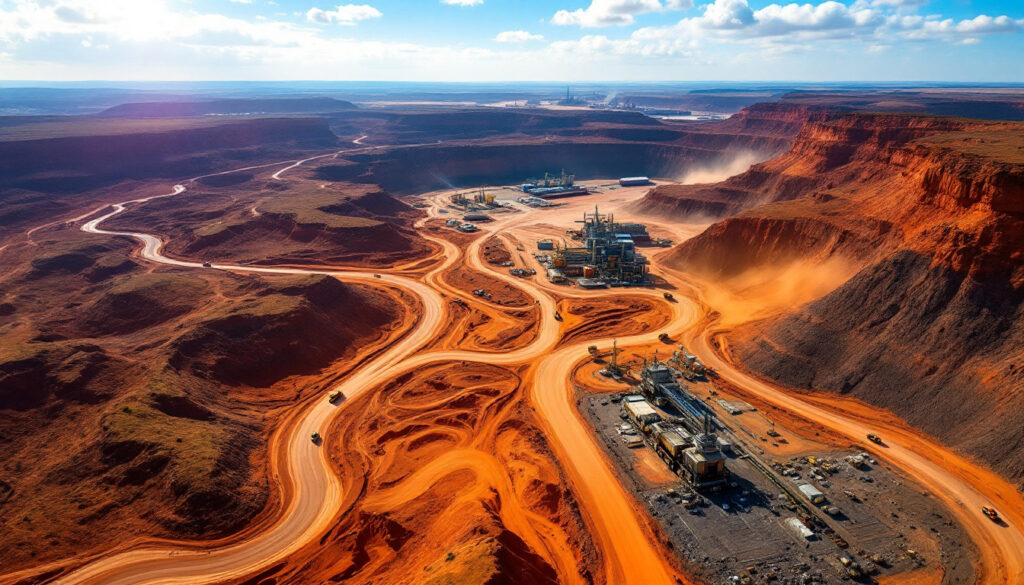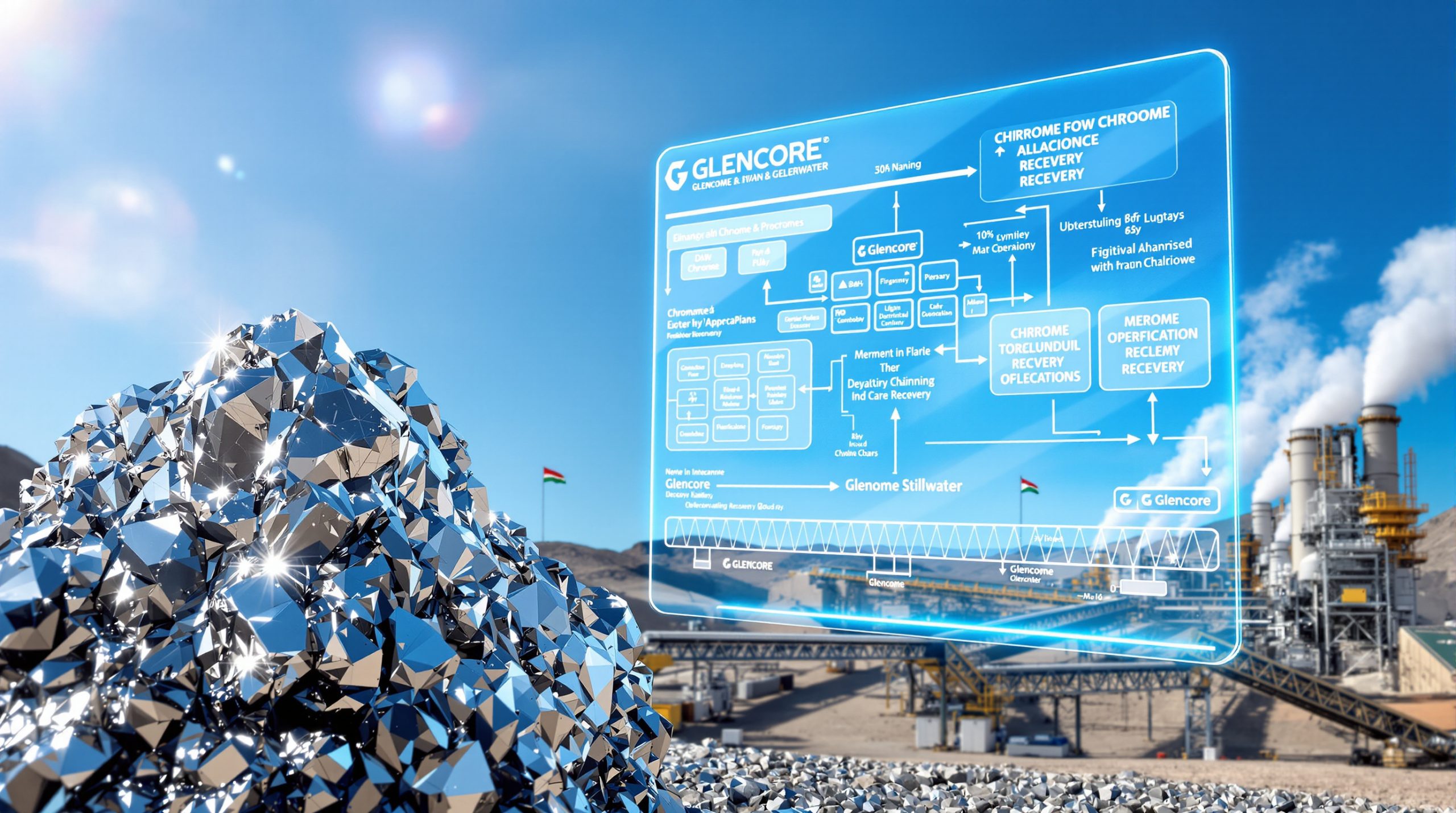BHP Shares and the ASX: A Comprehensive Analysis
What is BHP and Why is it One of the ASX's Most Valuable Companies?
BHP stands as a global mining powerhouse with an unparalleled presence in the resources sector. Headquartered in Melbourne, Australia, the company has strategically positioned itself as one of the Australian Securities Exchange's (ASX) most valuable enterprises, commanding respect from investors worldwide.
BHP's Global Presence and Operations
BHP operates across six continents with flagship projects spanning multiple commodities. Their expansive operations include the Western Australia Iron Ore (WAIO) network in the Pilbara, copper mines in Chile, and the developing Jansen potash project in Canada.
The company's diversified portfolio encompasses iron ore, copper, metallurgical coal, nickel, and potash, creating a balanced exposure to both traditional and future-facing materials. This strategic diversification significantly reduces BHP's vulnerability to individual commodity price fluctuations.
In FY24, BHP delivered impressive production figures, including 260 million tonnes of iron ore, 1.9 million tonnes of copper, and 22.3 million tonnes of coal. These volumes underpin the company's status as one of the world's premier resource producers.
A key strength lies in BHP's "Tier 1" asset strategy, focusing on deposits in the top quartile for size, quality, and cost position. Currently maintaining 12 such world-class assets, this approach ensures superior margins through commodity cycles.
BHP's Market Position
With an approximate A$180 billion market capitalization, BHP ranks as the second most valuable company on the ASX, trailing only Commonwealth Bank of Australia (CBA) at around A$260 billion. This exclusive club of ASX-listed companies valued above A$100 billion includes just five members: CBA, BHP, CSL, Westpac, and NAB.
BHP's scale dwarfs many competitors, including traditional rival Rio Tinto, which maintains a market cap below A$50 billion. This substantial valuation gap reflects investors' premium assessment of BHP's superior asset quality, management effectiveness, and long-term growth potential.
The company's scale delivers distinct competitive advantages, particularly in capital allocation flexibility and negotiating power with suppliers, customers, and governments. As noted by S&P Global analysts, "BHP's operational scale creates cost advantages smaller miners simply cannot match."
Trading at an EV/EBITDA multiple of approximately 6.2x (versus the ASX mining sector average of 8.5x), BHP offers relative value despite its premium market position.
Key Financial Metrics
BHP generated US$55.7 billion in revenue for FY24, resulting in US$7.9 billion profit from continuing operations. While these figures represent a decline from peak commodity cycle earnings, they demonstrate resilience in a challenging market environment.
The company achieved a Return on Capital Employed (ROCE) of 27.2%, significantly outperforming the mining sector average and reflecting efficient capital allocation. This metric highlights management's disciplined approach to investment decisions and operational excellence.
BHP paid US$1.56 in dividends per share during FY24, maintaining its commitment to shareholder returns despite commodity price pressures. With a dividend yield exceeding 5%, the stock continues to appeal to income-focused investors.
What Makes BHP Stand Out Among ASX Mining Companies?
Diversified Asset Portfolio
BHP's extensive collection of world-class assets across multiple commodities provides crucial insulation against market volatility. Unlike many competitors who concentrate on single commodities, BHP's balanced exposure reduces earnings volatility.
This diversification strategy has proven effective, with BHP experiencing 10-year revenue volatility of approximately 18%, compared to 35% for single-commodity focused miners like Fortescue. As noted by Nick Sundich at Stocks Down Under, "BHP's diversified portfolio reduces vulnerability to commodity price swings in ways pure-play miners cannot match."
The company employs an "options pricing" approach to asset development, balancing immediate production optimization against long-term reserve expansion. This strategy allows adjustment of capital allocation as market dynamics evolve.
Beyond diversification's defensive benefits, BHP's multiple commodity streams create strategic optionality when evaluating new opportunities. The company can pursue projects aligned with existing operations while maintaining exposure to emerging resource trends.
Production Scale and Efficiency
BHP's production volumes highlight its industry dominance across key commodities. The company's 260 million tonnes of annual iron ore production represents approximately 30% of global seaborne trade, providing significant market influence.
Following the OZ Minerals acquisition, BHP has cemented its position as the world's largest copper producer, with 1.9 million tonnes of annual production. This copper leadership is strategically crucial as global electrification drives demand growth.
The Pilbara iron ore operations epitomize production efficiency, with integrated mine-rail-port infrastructure consistently delivering C1 costs below US$15 per tonne. This cost position ensures profitability even during significant iron ore price trends.
Advanced technologies like autonomous haulage systems, predictive maintenance, and digital mining innovations have significantly improved operational reliability. At Escondida in Chile, these innovations have increased throughput by 15% while reducing maintenance costs by 20%.
Strategic Focus on High-Demand Commodities
BHP has strategically positioned itself in commodities essential for both traditional infrastructure and the energy transition. Iron ore remains the backbone of the portfolio, contributing 80% of group EBITDA and benefiting from continued urbanization trends.
The company's growing copper portfolio addresses accelerating demand from renewable energy, electric vehicles, and grid infrastructure. As BHP's Chief Economist noted, "Copper has emerged as the new oil for decarbonization, with demand growth outpacing supply additions."
BHP's copper assets boast exceptional longevity, with reserve lives exceeding 50 years at current production rates. The Olympic Dam operation in South Australia further diversifies returns by accessing significant uranium reserves (approximately 10% of global resources).
Strategic partnerships with end-users—exemplified by the Tesla nickel supply agreement—demonstrate BHP's forward-looking approach to securing demand for future-facing commodities.
What Challenges Does BHP Currently Face?
Decarbonization Perception
BHP faces the complex challenge of repositioning itself from a perceived carbon problem to a decarbonization solution. The company has committed to carbon neutrality by 2050, with an interim target of 50% reduction in operational emissions by 2030.
The divestment strategy has seen BHP exit thermal coal assets (including the A$2.5 billion Daunia/Blackwater sale) and petroleum operations (via the A$40 billion Woodside Energy merger). While these moves reduce direct emissions, critics from Climate Action 100+ argue they represent "greenwashing" rather than genuine transformation.
Diesel consumption remains a significant challenge, accounting for approximately 40% of operational emissions. The Pilbara electrification project aims to address this issue by investing A$1.5 billion in renewable power infrastructure, projected to eliminate 3.6 million tonnes of CO2 annually by 2030.
BHP increasingly emphasizes its role in producing metals essential for the energy transition, particularly copper and nickel. The company has committed A$6 billion to carbon capture research and development, acknowledging the necessity of addressing hard-to-abate emissions from metallurgical processes.
Commodity Price Pressures
BHP has faced significant headwinds from commodity price moderation, with FY24 realized iron ore prices declining 18% year-over-year to US$98 per tonne. This price pressure directly impacts profitability, with FY24 profit declining 39% to US$7.9 billion.
The company's dividend was consequently reduced by approximately 50% from record levels, reflecting management's commitment to maintaining balance sheet strength through market cycles. Despite this reduction, the yield remains attractive at over 5%.
Operational challenges have compounded price pressures, with weather disruptions (particularly Cyclone Ilsa) causing production losses of approximately 3 million tonnes of iron ore. Port maintenance activities further constrained shipment volumes during key market windows.
Regulatory adjustments have added additional cost pressures, with Chilean tax reforms increasing copper royalty payments by approximately US$400 million. Currency fluctuations, particularly AUD appreciation, resulted in hedging losses of US$1.2 billion.
Growth Outlook
Consensus estimates indicate modest growth prospects for BHP, with projected revenue of A$59.3 billion for the coming year representing a 6% decline. Earnings forecasts of A$2.07 per share reflect a 24% reduction from previous levels.
Trading at approximately 10x price-to-earnings and 2.5x enterprise value-to-EBITDA for FY25/26, BHP appears reasonably valued on traditional metrics. However, the PEG ratio of approximately 6x suggests potential overvaluation relative to growth expectations.
The uncertain Chinese economic outlook presents the most significant growth challenge, with steel output projected to decline 2% in 2025. As China accounts for over 70% of seaborne iron ore demand, this structural shift could fundamentally alter BHP's growth trajectory.
Organic growth opportunities remain limited, with major projects like Jansen Phase 1 potash representing significant capital commitments (A$12 billion) with extended development timelines. The acquisition landscape has similarly consolidated, limiting transformational growth opportunities.
How Do BHP Shares Compare to Other ASX Mining Investments?
Valuation Metrics
BHP shares currently trade with a consensus analyst price target of A$42.91, representing a potential 16% premium to mid-April 2025 price levels. This reflects generally positive sentiment among the 16 analysts covering the stock.
The forward price-to-earnings ratio of 10x compares favorably to the ASX 200 average of 15x, suggesting relative value despite growth concerns. Similarly, the enterprise value-to-EBITDA multiple of approximately 6.2x indicates reasonable valuation compared to historic levels.
BHP trades at significantly more favorable multiples than pure-play battery metal stocks, which have experienced substantial valuation compression following lithium price declines. The company's resource-per-tonne valuation (A$25) exceeds Fortescue's (A$18), reflecting quality and longevity premiums.
The company's beta coefficient of 1.1 against the ASX 200 demonstrates slightly higher systematic risk than the broader market, but significantly lower volatility than specialized mining stocks with betas exceeding 1.5.
Revenue and Earnings Projections
Analyst consensus projects BHP revenue of A$59.3 billion for the upcoming fiscal year, representing a 6% decline from previous levels. This contraction reflects expected commodity price moderation, particularly in iron ore.
Earnings projections of A$2.07 per share (down 24% from A$2.70) translate to a forward earnings yield of approximately 10%. While representing a significant decline from peak earnings, this level remains attractive compared to fixed-income alternatives.
Concerns about peaking iron ore demand from China represent the primary driver behind conservative forecasts. With Chinese property sector challenges ongoing and steel production potentially plateauing, the market anticipates structural rather than cyclical headwinds.
The projected earnings decline contrasts with expected growth in copper-focused producers, where supply constraints and electrification demand support more bullish forecasts. Similarly, uranium producers enjoy significantly stronger growth projections as nuclear sentiment improves globally.
Investment Alternatives
For growth-oriented investors, superior opportunities likely exist among lithium and uranium project developers, which collectively demonstrate average projected revenue growth of 40% versus BHP's modest decline. Companies like Azure Minerals (ASX:AZS) have delivered exceptional returns (+300% in 2024) following resource discoveries.
Income-focused investors continue to find value in BHP's dividend history and policy. Typically paying around 50% of profits as dividends, the company maintains one of the ASX's more reliable income streams despite cyclicality.
Barrenjoey analysts suggest a barbell approach, noting: "BHP suits income investors seeking stability; developers appeal to growth seekers willing to accept higher volatility." This strategy allocates core holdings to established producers while maintaining satellite positions in development stories.
Risk-adjusted return analysis suggests BHP offers superior performance during inflationary environments, with commodity exposure providing natural hedging qualities. JPMorgan analysts highlight that "BHP historically outperforms during inflation spikes," making it a potential portfolio stabilizer during monetary uncertainty.
Should You Invest in BHP Shares in 2025?
Current Investment Case
The declining revenue and earnings outlook makes immediate investment in BHP less compelling, particularly for momentum-focused strategies. With consensus projecting earnings contraction of 24%, near-term capital appreciation appears limited.
Long-term fundamentals remain robust, however, with world-class assets, industry-leading margins, and strategic positioning in future-facing commodities. The company's strong balance sheet (net debt of US$16 billion, down from US$26 billion in 2022) provides flexibility through market cycles.
The dividend yield of approximately 5.2% significantly exceeds the ASX 200 average of 4.1%, providing income support despite potential share price stagnation. BHP's dividend reinvestment plan (DRP), with a 35% participation rate, further enhances long-term compounding potential.
Dollar-cost averaging strategies may prove effective given BHP's cyclical nature, allowing accumulation during inevitable market corrections. Morningstar suggests this approach "mitigates cyclicality risks while capturing attractive yield points."
Risk Factors to Consider
Commodity price volatility remains the primary risk, with iron ore price forecasts ranging from US$90-110 per tonne over the next 12 months. Current Chinese port inventories (95 days versus the 5-year average of 80) suggest potential oversupply in the near term.
Chinese economic deceleration presents a structural rather than cyclical challenge, particularly for iron ore demand. With urbanization rates plateauing and environmental restrictions increasing, steel production growth appears limited.
The energy transition presents both opportunities and threats. While copper and nickel benefit from electrification trends, BHP's metallurgical coal exposure faces long-term substitution risk from hydrogen-based steel production technologies.
Geopolitical tensions, particularly between Australia and China, create additional uncertainty. While iron ore trade has generally remained insulated from diplomatic frictions, potential tariffs or quotas represent a material risk factor.
Alternative Investment Strategies
Investors might consider entry points during market corrections, particularly when BHP trades below its 200-day moving average (currently A$38.20). Historical analysis suggests such opportunities typically emerge 2-3 times annually.
Options strategies provide alternative approaches, with covered calls generating additional income during range-bound periods. With 30-day average volume exceeding 10 million shares, options markets offer sufficient liquidity for institutional strategies.
Evaluating BHP within a diversified portfolio context remains essential. The company's 60% institutional ownership concentration (top 20 shareholders) highlights professional investors' preference for balanced exposure rather than concentrated positions.
Relative value trades comparing BHP against global peers like Vale on the NYSE can potentially capitalize on regional valuation discrepancies while maintaining sector exposure.
FAQs About BHP Shares and ASX Mining Investments
How has BHP's share price performed historically?
BHP shares have delivered a 10-year compound annual growth rate (CAGR) of approximately 9% including dividends, outperforming the broader ASX 200 index. This performance demonstrates the company's resilience through multiple commodity cycles.
During the 2020 COVID-19 market disruption, BHP experienced a maximum drawdown of approximately 40% (to A$24.50), but subsequently recovered to new highs as stimulus measures supported commodity prices. This pattern of sharp corrections followed by sustained recoveries typifies the stock's behaviour.
The dividend policy has provided consistent income for long-term investors, with payout ratios averaging 50% of underlying profits. This approach balances shareholder returns with capital retention for growth opportunities.
Technical indicators show current neutral positioning, with the Relative Strength Index (RSI) at 45 and price hovering near the 200-day moving average of A$38.20. This suggests balanced market sentiment without extreme positioning.
What is BHP's approach to ESG and sustainability?
BHP has committed to carbon neutrality by 2050, with a detailed roadmap including a 50% reduction in operational emissions by 2030. The company has allocated 30% of capital expenditure to "future-facing" commodities that support decarbonisation.
Divestment from thermal coal and petroleum assets has significantly reduced direct emissions, though critics argue this merely transfers environmental impacts rather than eliminating them. The company maintains metallurgical coal operations as essential inputs for conventional steelmaking.
Social performance metrics show improvement, with female workforce representation reaching 30% (a 10 percentage point increase since 2020). Indigenous employment and community investment programmes similarly demonstrate positive trajectories.
The A$500 million Nature Positive fund represents a significant commitment to biodiversity restoration and conservation, particularly in regions impacted by historical mining activities. This initiative acknowledges the extractive industry's responsibility for environmental remediation
Want to Get Ahead of the Next Major Mineral Discovery?
Discovery Alert's proprietary Discovery IQ model instantly notifies investors about significant ASX mineral discoveries, providing actionable insights for both short-term traders and long-term investors. Visit our discoveries page to understand why major mineral discoveries can lead to substantial returns and begin your 30-day free trial today.




